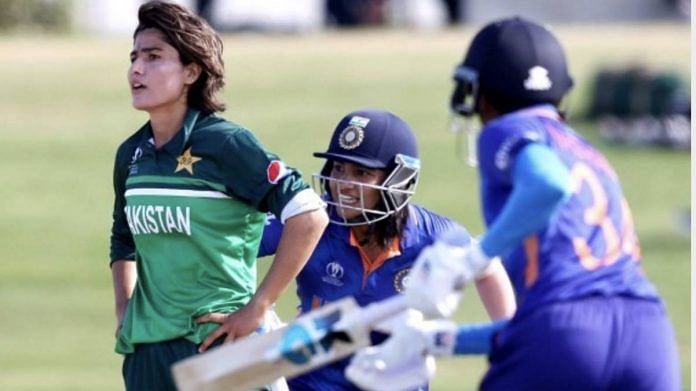New Delhi: On a batting friendly-wicket with a lightning-quick outfield at Mount Maunganui’s picturesque Bay Oval Sunday, India’s Women’s World Cup campaign nearly got off to a disastrous start with what could have been their first ever defeat to Pakistan in women’s ODI history.
However, lower-order batters Pooja Vastrakar and Sneh Rana rescued India from 114-6 by stringing together a match-winning 122-run partnership from 100 balls. Instead of what could have been a sub-150 score, the final target of 245 was well beyond the reach of Pakistan’s brittle batting line-up as Mithali Raj and her Women in Blue completed a 107-run victory.
As a result of the crushing victory, India move to the top of the table with a significantly high net run rate, and will now face the New Zealand White Ferns at Hamilton’s Seddon Park on 10 March. Although the White Ferns lost by 3 runs to the West Indies in a thrilling last-over upset, the Women in Blue will need to improve their decision-making with the bat in the middle overs to maintain their winning start.
Also read: Lots of practice but patchy record — where India stand as ICC Women’s World Cup begins Friday
Middle-order collapse
In the first 20 overs of India’s batting innings, in-form Smrithi Mandhana and Deepti Sharma had set up a solid platform after overcoming early pressure from Gilgit-Baltistan pacer Diana Baig and left-arm spinner Anam Amin.
But once Amin was joined by fellow spinners Nashra Sandhu and Nida Dar, the boundaries dried up and scoreboard pressure kicked in. The trio had found the ideal balance between good length and fuller deliveries to attack the Indian batters, extract a bit of turn and induce a greater percentage of edges and false shots.
Soon enough, it was Sharma’s dismissal to Sandhu via an ugly attempt at a pull shot that triggered a middle-order collapse. Mandhana’s poor chipped shot straight back to Amin was followed by Harmanpreet Kaur, Richa Ghosh and Mithali Raj making fatal mistakes while trying to hit their way out of trouble.
By the time Raj edged a mistimed hoick to point in the 34th over, India had not hit a single boundary for more than 13 overs. But when Rana and Vastrakar were at the crease together and showed the patience and application their seniors lacked, it looked like India would gradually move out of the mire.
Counterattack
From the get-go, Vastrakar targeted boundaries almost exclusively on the off-side while Rana showed more all-round play to pick out gaps, ensuring that the duo kept rotating the strike. Pakistan captain Bismah Maroof had shown excellent tactical nous with attacking fields to force rookie mistakes from the Indian middle order, but had little response to the repeated counter punches from this lower-order pair.
Instead, the spin trio’s bowling plans became increasingly defensive, their lines strayed wider and lengths far shorter, playing completely into Vastrakar and Rana’s hands. According to the broadcaster’s pitch map, just 27 per cent of the spinners’ deliveries were of fuller length, while a combined 68 per cent were either good length or too short.
Vastrakar and Rana scored 12 boundaries between them overall, but their continued aggression and merciless punishment of loose deliveries exposed Pakistan’s lack of quality at the top level as Maroof’s fielders succumbed to the newfound pressure with sloppy errors.
As a result, what was initially a face-saving partnership to take India close to 200 ballooned into a world-class mature performance for the ages that deflated the confidence of their arch-rivals. Last week, Pakistan had successfully chased down 230 against New Zealand in a World Cup warm-up game, but they showed a lack of composure Sunday with indecisive shot selection and static feet movement.
The well-drilled Indian bowling attack rarely erred from their plans and never really needed to be in top form as Maroof and company struggled to pick easy singles from the first few overs on. Ultimately, Rajeshwari Gayakwad and veteran Jhulan Goswami were the pick of the bowlers, but the game’s outcome had quickly become academic within the first 15 overs of the Pakistani innings.
(Edited by Rohan Manoj)
Also read: T20 World Cup: What can women’s cricket do to enjoy the popularity of men’s cricket?






